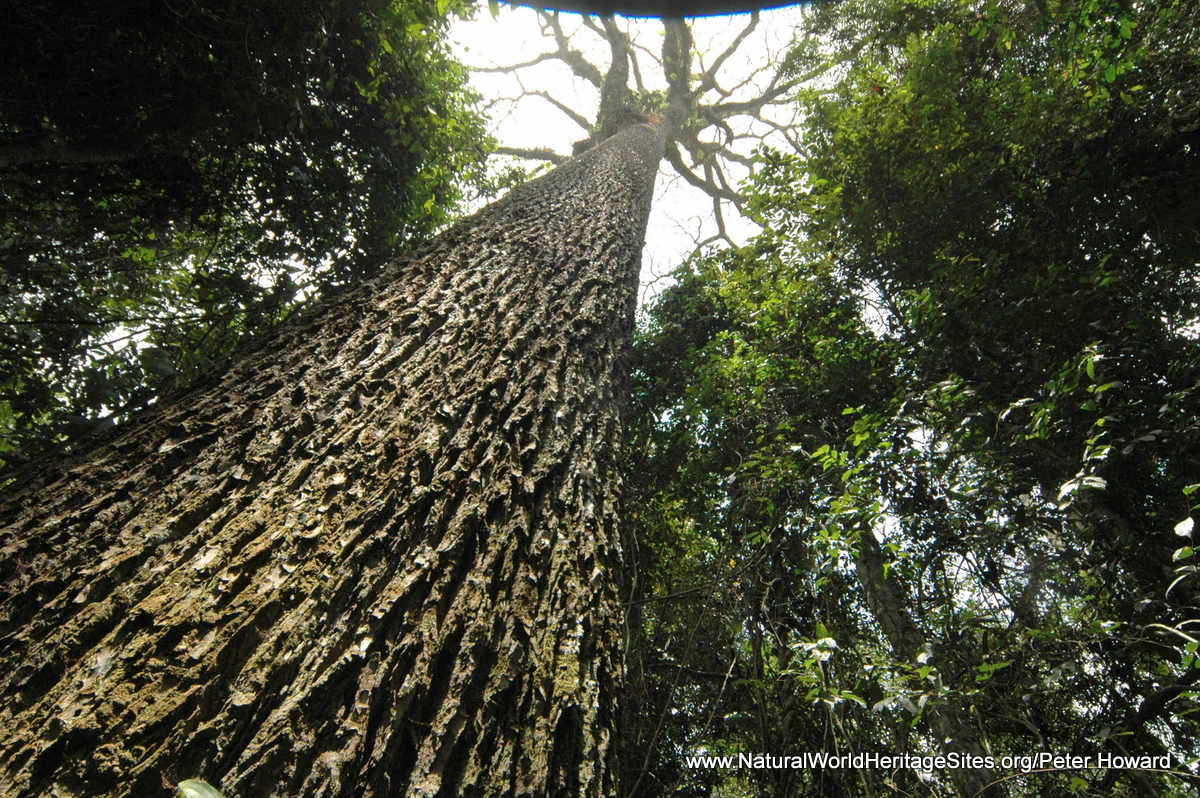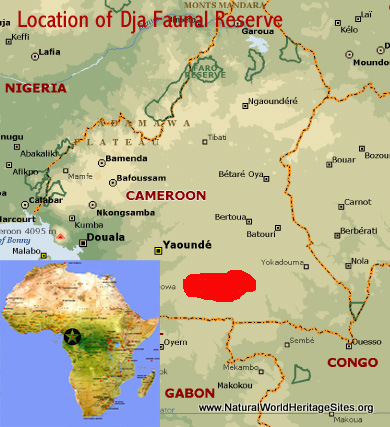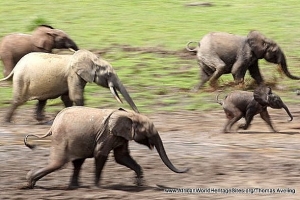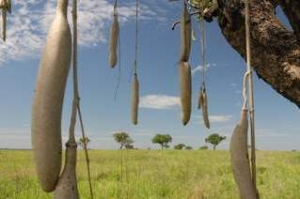EXPLORE CAMEROON’S DJA FAUNAL RESERVE with this slideshow, check the location map and get all the facts and information below.
For slideshow description see right or scroll down (mobile). Click to view slideshow
REVIEW OF WORLD HERITAGE VALUES: According to IUCN’s Conservation Outlook Assessment (2014), the specific attributes which qualify Dja Faunal Reserve for world heritage status can be summarised as follows:
Diversity of primate species. Although Dja Faunal Reserve is poorly studied, it is known to support at least 14 primate species including western lowland gorilla, chimpanzee, greater white-nosed guenon, moustached guenon, crowned guenon, talapoin, red-capped mangabey, white-cheeked mangabey, agile mangabey, black and white colobus monkey, drill and mandrill, as well as the nocturnal potto and Demidorff’s galago. Very few sites elsewhere in Africa support such a high diversity of primates in a single location.
Exceptional diversity of other plant and animal species. The Dja Faunal Reserve is believed to be one of Africa’s most species-rich rainforests, although little is known of most groups of plants and animals. More than 100 species of mammals have been recorded.
Habitat of globally threatened species. In addition to the globally threatened primates listed above, other endangered large mammals that occur in Dja Faunal Reserve include forest elephant, bongo and leopard. Threatened birds include Bates’s weaver (which is endemic to southern Cameroon) and the extra-ordinary grey-necked rockfowl (Picathartes). Reptiles include two species of forest crocodile, both of which are globally threatened.
Primary rain forest with rich and varied ecosystems. Dja Faunal Reserve is notable for the diversity of its species and the pristine condition of its primary rainforest ecosystem. Situated at the heart of the Congo Basin, the reserve covers a diversity of topographical, bio-geographical and geological gradients with a resulting diversity of forest types. The vegetation comprises dense evergreen Congo rainforest with a main canopy at 30-40 m rising to 60 m, rich in lianes and with a diverse shrub layer below the main canopy. Mixed-species stands of rainforest are interspersed with almost pure stands of ‘mono-dominant Gilbertiodendron dewevrei forest, as well as areas of riverine and swamp vegetation. Some secondary forest is found around some old villages (which were abandoned in 1946) and this contributes to overall habitat diversity.
CONSERVATION STATUS AND PROSPECTS: There is significant concern for the overall outlook for conservation of Dja Faunal Reserve’s world heritage values. Poaching is probably the single greatest threat to the area’s wildlife, especially in the eastern sector of the reserve where an organized network of commercial trade in bushmeat and other wildlife products appears to function. The poaching threat is exacerbated by an influx of people drawn to the peripheral areas of the reserve by a growing number of development projects including mining operations, dam construction and plantation development. The reserve’s management authority lacks the financial, technical and human resources to control poaching effectively and address some of the other major threats, so populations of key wildlife species are probably in steep decline (although the lack of scientific monitoring data makes this hard to verify). The natural values of Dja Faunal Reserve are still present, but a major improvement in management effectiveness is required to halt, and ultimately reverse the present trend in degradation of resources.
MANAGEMENT EFFECTIVENESS: Poaching pressure within the reserve is increasing rapidly (with the demand for bush meat), and the management authority has been largely unable to control it due to lack of resources. Additional conservation funding has been awarded recently and it is hoped this will help strengthen management and improve enforcement, supervision and control. An important element of the enhanced management effort will be to monitor the effectiveness of anti-poaching actions and adapt management interventions in the light of experience.
REVIEW OF CONSERVATION ISSUES AND THREATS: The following issues represent specific threats to the ecology, conservation and values of the Dja Faunal Reserve.
Illegal commercial hunting. Commercial poaching is increasing and currently represents the main threat to the site. In 2008, 2,983 illegally-hunted animals were seized in the course of 308 anti-poaching patrols, while in 2010 this number increased to 8,919 animals seized by only 101 patrols. Poaching is widespread within the reserve, notably in the eastern sector of Lomié where an organized network appears to function with the support of local elites. Poaching pressure is likely to increase further as people are drawn into the areas around the reserve by new industrial and energy-related development projects, requiring greater anti-poaching effort.
Subsistence hunting. Traditional hunting by members of the indigenous communities is permitted within the reserve as part of their agreed user rights. As long as this does not affect protected species or become commercialized, subsistence hunting at present levels of offtake is not considered to be a major threat to wildlife.
Logging. Logging is widespread in the forests around the periphery of Dja Faunal Reserve, where it is carried out by private concessionaires and local communities. Although this does not have a direct impact on the integrity of the reserve, it facilitates access by poachers and increases the ecological isolation of the reserve (thus affecting natural animal migration patterns, seed dispersal and other ecological functions). There is a risk that logging activity may spread into the reserve illegally, especially as timber resources in peripheral areas are depleted.
Mining. Although there are no existing mining operations in the reserve or its immediate vicinity, the prospect of future mining operations is a real potential threat to the integrity of the reserve. Numerous mineral exploration licenses have been granted for areas around the periphery of the site, one of which also covered about 20% of the reserve (until it was revoked in 2013). There is concern over the recent award of a license to exploit cobalt and nickel from an area about 40km to the north of the reserve without adequate environmental and social impact assessment and other similar cases are likely to emerge in future.
Dam construction. The “Mekin” dam is currently under construction at the confluence of the Mekin and Dja Rivers and, on completion, the resulting reservoir will flood part of the world heritage site with corresponding loss of riverine habitat. The construction phase has already brought an influx of people and this is beginning to result in the development of spontaneous settlements, illegal logging and clearing for crop production, hunting, fishing, and poaching. Whilst the environmental and social impacts of the dam are recognised, the project does not appear to include appropriate measures to mitigate the impacts of the dam on the reserve’s world heritage values.
Crop production. A concession covering 452 km2 of land adjacent to Dja Faunal Reserve has been awarded for the development of rubber, oil palm, and cocoa plantations by the Cameroun company, Sud Hevea. According to the operator, this could result in the arrival of some 30,000 new immigrant workers and associated people. The potential impact of such a large population living close to the reserve – in terms of pressure for bushmeat, other forest products and economic opportunities – is severe and requires effective management if the integrity of the reserve is to be maintained.
Slideshow description
The slideshow provides a comprehensive overview of Cameroon’s Dja Faunal Reserve, showing the area’s landscapes, wildlife habitats, plants and animals, threatened species, conservation management issues, local community livelihoods and some of the visitor facilities.
Factfile
Website Category: Tropical and Sub-tropical Forests
Area: 5,260 km2
Inscribed: 1987
Criteria:
- (ix) ecological processes;
- (x) biodiversity





